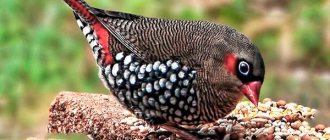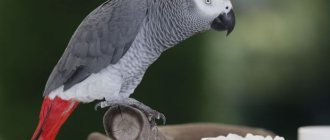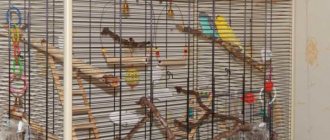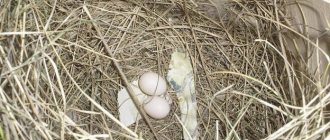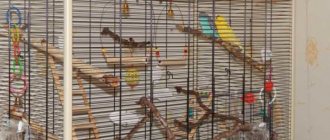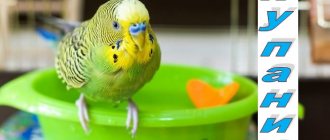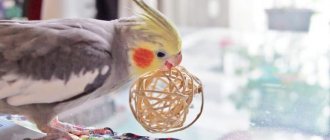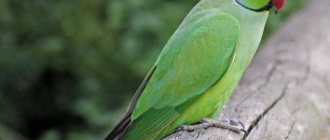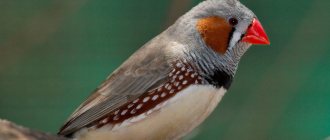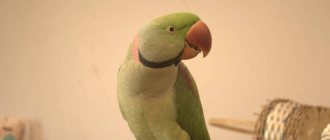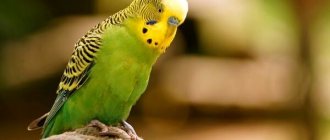But let's talk in more detail about the breeds and how to care for a parrot
and about the most interesting thing: how to teach a parrot to talk.
Parrots, even the simplest budgies, can live up to 20 years . During this time, your pet will become your loyal friend and family member. But first you need to learn how to take care of him, because caring for a parrot
- this is the main thing. Let's proceed to the analysis and start with the breed of birds.
What kind of parrot lives with you?
You choose a budgie: where to start caring for the bird
At the first inspection, you need to pay attention to the fact that the chick is active. This can be determined by rapid springy movements, quick reactions, and a desire to interact with the outside world. He should have shiny eyes, smooth plumage that fits tightly to the body, light breathing without hoarseness and clean feathers in the anus.
Budgerigars have a variety of colors
It is also necessary to examine the beak, which should be smooth, dry, without secretions and foreign formations, the wax and paws, which should not show signs of peeling. The claws should not peel off. Caring for a budgie will be easier if you have information about the bird.
Boy and girl budgerigar
It is also important to make sure that the bird is young enough, this can be determined by the wax (in young birds it is always a delicate pale pink or bluish color), by the frontal feathers decorated with contrasting colored stripes (by 6-7 months of age these stripes are highlighted) , and in the eyes (in chicks they are uniformly dark, in adults a gray and later a white rim appears along the outer edge).
Budgerigar chick
If the sex of the bird matters for the purchase, since there is an opinion that males are more talkative, then the “boy” chick has a lilac cere (in an adult it is deep blue), the “girl” has blue, white, beige, (in an adult it is brownish ) around the nostril openings there are characteristic white rings.
Video: how to determine the sex of a budgerigar
If we talk in general about breeds of parrots, then the most popular, affordable and easy to keep will, of course, be the budgerigar, whose homeland is the grassy plains of Australia. Cockatiels and lovebirds are also quite popular.
Lovebirds
Corella is also an Australian, the smallest member of the cockatoo family, and lovebirds are native to Africa and Madagascar. Their small size makes it possible to keep these beauties in an ordinary apartment, in a fairly compact cage, without any problems. When choosing a larger bird (for example, a Gray), it is important to take into account that it needs a large, spacious cage or aviary.
Physiological molting
Loss of feathers occurs in young parrots at the age of 4-5 months. If the first shedding has not begun at 5 months, a veterinarian will be required. The diet may need to be adjusted to ensure the bird is getting enough nutrients.
Juvenile
Biologists called the first change of feathers juvenile. The duration is 2-3 months, which is significantly longer than the molting of parrots in adulthood. After the process is completed, the pets become sexually mature individuals.
Seasonal
Every spring and autumn, domestic birds begin to molt. Usually at this time it is difficult for birds to fly, so the cage door is kept locked. When changing feathers, the immunity of budgies is weakened, and they become easy prey for viral infections. The absence of drafts, a warm room and nutritious food will help protect your pet from illness.
The molting of parrots begins with the loss of down. Birds grab the perch tightly and actively flap their wings to remove old fluff.
The next phase is changing feathers. They are updated in the following sequence:
- stomach;
- breast;
- head;
- wings;
- tail.
Large feathers may not change for a whole year. During molting, small white tubes appear on the bird's body, from which new feathers then develop. Over time, the tubes fall apart into small particles, like dandruff.
Interesting! If the molting of a budgerigar proceeds slowly, then the bird begins to pull out feathers on its own.
Features of feeding budgies
A budgerigar needs not only careful care, but also proper feeding.
The main components of the diet are as follows:
- greenery;
- cereals;
- fruits and vegetables;
- proteins.
Wavys need to be fed with greens.
The basis of the diet is grain feed. Nowadays there is a large selection of food for different types of birds on sale, so you can easily choose the one that suits your pet. You can supplement it with porridges (buckwheat, rice, millet). It is necessary to give your pet fresh greens:
- dandelion leaves;
- salad;
- dill;
- spinach;
- plantain;
- wild cereals;
- dried nettle.
Fruits and vegetables are also beneficial:
- banana;
- orange;
- apple;
- pear;
- pieces of zucchini or pumpkin;
- grated carrots;
- beet;
- turnip;
- berries.
Parrots eat pears.
Chopped eggs and stale white bread are suitable as protein foods.
It must be remembered that your pet should always have a drinking bowl with fresh water, to which you can periodically add a few drops of lemon, orange or grapefruit juice.
Attention to prohibited products
To the above products we will add cucumbers, beets, cabbage, tomatoes and melons. Before feeding the parrot into the feeder, vegetables and fruits must be washed and cut into small pieces (you can grate them).
Fresh greens, such as spinach or lettuce, are beneficial for parrots of all breeds. Give the birds berry crops - strawberries, raspberries, cranberries, currants, sea buckthorn. Pears and apples, pomegranates and grapes, plums and cherries will not be damaged.
You should not feed parrots with persimmons, avocados, mangoes and papaya. Eliminate plants with a pungent taste - onions, garlic, eggplants, radishes and radishes, celery, dill, cilantro. To “warm up” the beak, place tree branches in the bird’s cage - linden, birch, rowan, alder, chestnut, maple. Acacia, oak, poplar and conifers are not suitable for this purpose.
Keeping a budgerigar: criteria for choosing a cage
When buying a cage, it is important to understand that it is your parrot's home, so he should feel comfortable in it. Keeping budgies should begin with the choice of future “apartments”. Spacious and multi-tiered, with the ability to install perches, rings, toys, several feeders, a drinking bowl, a bathing container - an ideal choice, partly compensating for being kept in captivity.
It is also important that the cage is easy to use and made of durable material. A cage with metal bars would be the best option, since a wooden one has a risk of parasites and is guaranteed to absorb and stagnate a specific odor.
You should not place the cage too close to the window, as drafts may cause the bird to get sick.
It is advisable to structure the parrot’s keeping regime so that it has the opportunity to spend as much time as possible outside the cage, fly, move, and communicate. An insufficient number of flights will quickly affect your health, primarily on your respiratory function, which is directly related to the functioning of the wings.
How often should you clean your cage? The care and maintenance of budgies at home requires a number of rules. We need to start with cleanliness. As you know, cleanliness is the key to health. That is why cleaning should be done daily.
The cage needs to be cleaned regularly
If for some reason (departure, busyness, natural laziness) this does not work out, then you can add wood filler to the sand in the tray of the cage, as for a cat litter box, so that it absorbs the smell and moisture, but you should not abuse it.
It is necessary to clean the perches of droppings, pour boiling water over the drinking bowls, and remove husks and remaining food from the feeders. Sand and absorbent paper must be changed once a week. You should also disinfect the cage with a 1-2% solution of potassium permanganate.
Video: how to choose a cage for a budgie
Housing preparation
The cage has been purchased, what next? Next you need to purchase all the necessary accessories and items. For example, you need to take care of a good feeder and a convenient drinking bowl. Another important thing is perches and at least some toys. Let's look at these points in more detail.
What kind of feeder and drinker should be for parrots?
The best option for feeding feeders would be metal bowls that can be fixed at a height.
Such bowls will resist bird beaks and will always be accessible. They can be open, but with high sides so that food does not fall out. The feeder, if the cage has a special door, can also be attached to the outside of the cage.
As opposed to a bowl, the drinking bowl should not be open, otherwise it will be inconvenient for the birds to drink the water and it will quickly become dirty. In stores you can easily find a good drinking bowl - they are a vertical container from where water flows into a special hollow, from where parrots can drink water.
Perches are a necessary attribute of a parrot's home; these cute birds spend most of their time on them, and they sleep on them. You can use metal rods or thin pipes as poles, but this is not the best option, although it is more durable. Metal is a slippery material and it is uncomfortable for birds to hold on to. It’s better to buy wooden perches; you can make them yourself by taking a stick of suitable diameter. The diameter of the pole should be the size of the paw so that it can be almost completely encircled.
To entertain your parrot, you can place a mirror, various twigs, perches, and even small bridges inside the cage.
Communication with a budgie is an important component of care and maintenance
In addition to the nuances discussed above, it is important not to forget about communication. After all, when purchasing a parrot, you want to get a friend or home decoration, so you should not reduce the care and maintenance of budgies to cleaning the cage. You need to devote time to the bird itself.
Parrot needs attention
The first rule is not to force yourself on the bird, give it the opportunity to get comfortable, to understand that it has everything it needs for a comfortable existence (including peace).
After your pet gets used to you and the new environment a little, you need to let him out of the cage. It makes sense to wear clothes made of thick, easy-to-clean fabric for these cases if you want to train your feathered friend to ride on your shoulder like a pirate, but don’t want to be scratched by claws or “marked.”
A budgie on your hand is an indicator of trust
The effectiveness of the learning and taming process of words and phrases will depend on many factors. For example, it depends on the breed, age, and whether the parrot is kept alone or in a pair (in this case, the birds are usually busy with each other). Grays, for example, are considered the most capable and susceptible to remembering human speech.
There is an opinion that the more often you repeat the same phrase or word, the faster the bird will remember and reproduce it. This is not true, but sometimes a pet can remember a phrase it has heard only once. Particularly talented ones can even convey entire dialogues and quotes from films verbatim, as well as imitate various sounds: car alarms, dog barking, mobile ringing, and even maintain some illusion of a conversation with the owner, which greatly amuses both owners and guests.
Video: how to teach a wavy to speak
Budgerigars are more predisposed to reproducing human speech; it is much more difficult to teach a cockatiel or lovebirds to speak. There is no point in turning the process into training, just talk to your winged counterpart every day, as you would with a family member, then the need to respond to you will come to the bird on its own.
Toilet training
Several dozen toilet-finding exercises will make life easier for the parrot and its owners. Owners can teach their pet to defecate in the same place in the cage, which will make cleaning the home easier.
One person should train the pet.
- You need to come up with a short phrase that will guide the bird's mind while searching for a toilet. For example, "Dli"!
- If the first “symptoms” of the desire to go to the toilet are observed (behavior changes: moving backwards, lifting, moving the tail, etc.), it is recommended to take the bird and hold it over the tray (which should be in one place).
- When you bring your pet over the latrine, you need to say exclamation: “Long!”
Carry out training as often as possible until you get a positive result. The parrot will get used to the place and will independently go to the designated container.
If the result is negative, the bird cannot be punished or scolded, but it is better to potty train it within 4 months.
Budgerigar diseases and precautions
Keeping a parrot at home is a responsible task also because you need to monitor the pet’s health and understand how to care for it. To eliminate the possibility of drafts, so as not to chill the delicate tropical creature, install additional protective nets on the vents and windows to prevent accidental flight outside the apartment.
Mosquito net will protect parrots from flying out
Closely observe the behavior of the wavy. Lethargy, drowsiness, photophobia, and refusal to eat may indicate the onset of the disease. Some of the diseases, being infectious, can be transmitted to people. We are talking about diseases such as:
- Salmonellosis. It is difficult to detect; often the bird is only a carrier, a reservoir of the disease.
- Tuberculosis. It is characterized by deterioration of the plumage, the appearance of ulcers and enlarged lymph nodes. There is practically no treatment for birds.
- Arizonaosis. With arizonosis, anorexia, weakness, and tremors develop, but timely measures taken give a positive outcome.
- Chlamydia. Signs of chlamydia in parrots: diarrhea, cough, nasal discharge. It happens very quickly, often with a deadly ending.
Most of the listed diseases are transmitted by bacteria in the droppings, therefore, if infection is suspected, it would be useful to clean the cage wearing a protective mask and medical gloves.
Video: how to rid your budgie of ticks
Education
Most often, parrot owners wonder if their pet can talk. It is possible to teach speech to any parrot.
- The learning process should be carried out by the person whom the bird is not afraid of.
- Start with simple phrases, such as your pet's name.
- Your intonations should be soft and your mood friendly. Be patient, it will take you from 2 months to six months for your pet to talk.
- Remember that you can only teach speech if your parrot lives alone. When he learns to talk, feel free to buy him a friend.
Breeding budgies at home
If your plans include increasing the population of flying pets, then this will require the creation of a number of conditions for reproduction. Breeding parrots in an apartment is not a difficult task, but it is troublesome.
The most difficult thing is to choose a pair and understand how to properly care for a budgie if it lives with a “family”. Breeders who have several individuals and, accordingly, room for choice, do this by observing the parrots in a large aviary.
If parrots mutually care for their plumage, treat each other, feed each other, and “kiss”, then they have every chance of having offspring. Then, if necessary, you need to artificially increase the daylight hours to 14-16 hours, equip the cage (preferably with two doors) with a “nest” - a house closed from prying eyes, where the female could calmly lay a clutch and hatch the chicks. Proper care and feeding of budgies is especially important during this period!
During this period, along with the usual grain mixture and juicy additives, they should be fed with sprouted grain, soft, easily digestible food. The quality of the masonry can be checked after a week using a flashlight or an ovoscope. If the female has settled stably on the eggs, and the male has taken care of her, there is hope that the pair has taken off.
When partners quarrel, the mother often leaves the nest, abandoning the clutch to the mercy of fate, or deliberately breaks the shell (which happens with young, inexperienced birds), it makes sense to replace one of the parents. By observing all the criteria for proper maintenance, it is quite possible to get beautiful, colorful, healthy offspring from your couple.
Video: breeding budgies
Care during shedding
During this period, feathered pets require increased attention and special care. The latter consists primarily of some dietary changes.
Balanced diet
The correct diet is one of the keys to a bird’s successful passage through the period of plumage renewal. It must necessarily include:
- Fruits.
- Vegetables.
- Salads with the obligatory inclusion of sesame seeds.
Sometimes the owner does not have time to make special birdseed on his own. Then it is better for him to buy it in the store. Manufacturers have long developed and began to sell special foods for the molting period.
Vitamins and minerals
The life period under consideration is characterized by an increased consumption of nutrients by the parrot’s body. After all, new feathers cannot appear out of nowhere. Therefore, at such moments it is extremely important to maintain mineral and vitamin balance. In this regard, experts and experienced lovers advise adding to food:
- Mineral supplements. They can be diluted with sulfur at the rate of a piece of sulfur the size of a match head per 2 teaspoons of mineral supplement.
- Honey.
- Sepia.
Bathing and humidity
At this stage of life, the pet urgently needs optimal air humidity in the place where it is kept and regular water treatments. Parrots generally do not like dry air, and during the molting period they react to it more sharply. Humid air will help your feathered pet restore its skin and plumage faster and feel much more energetic. In this regard, it is highly advisable to install a humidifier in the room with the cage and adjust its operating mode.
During molting, parrots especially love to bathe. Therefore, there should always be warm water in bathing suits. Cold water can cause a cold. The room where the cage is located should be warm. Windows should be closed while swimming. Drafts can lead to colds.
Air temperature and humidity: comfortable conditions for keeping a budgie
Many parrots tolerate a decrease in temperature for a short time normally. Despite this, you should not allow the bird to stay in a cold room for a long time or expose it to noticeable changes in degrees.
Temperature is very important for the wavy
The recommended temperature for optimal keeping of parrots is from 18 to 20 C. Under these conditions, a favorable atmosphere is created for full life activity, but during breeding it should be lowered by 2-3 units.
A successful pair of budgies
Temperatures should not be allowed to exceed the established norm, as this can lead to a deterioration in the bird’s well-being, decreased appetite and impaired reproductive function. It is known that when the temperature regime is violated, a large percentage of unfertilized eggs is observed. Lower temperatures have a positive effect on the processes of reproduction and fertilization. The level of air humidity should also be given sufficient attention.
For the room in which the bird is located, the humidity should be in the range of 70-80%. The temperature is kept at 15-20 C.
Control of humidity levels is necessary when temperature changes. High humidity can cause hypothermia in a parrot.
How often do birds molt?
So, normally, budgies molt once or twice a year. Moreover, this process has a certain periodicity.
As a rule, molting of plumage in domestic parrots occurs after winter. Birds shed the dense plumage that has formed over the winter. The second moult occurs in the fall. However, not all individuals change feathers twice a year.
Separate mention should be made of this process in sexually mature females. Thus, laying eggs and caring for chicks takes a lot of energy from birds. Therefore, after hatching the chicks, molting can be observed in females for 1-2 months.
